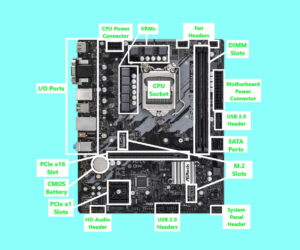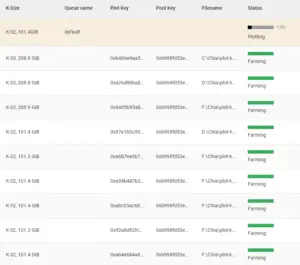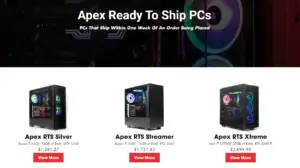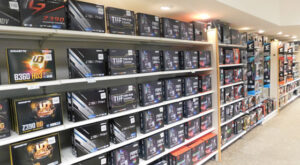Introduction to AMD Chipsets
We recently released a guide to Intel’s 500-series chipsets, and thought it would be helpful to add a comparable guide addressing AMD’s side of things. While AMD’s names are structured slightly differently, the same general rule applies: the last two numbers of the suffix (e.g. A520) indicate a board’s relative position in the overall stack. Thus, any given X570 motherboard will have better features than a comparable B550.
Chipsets are useful because they’re an easy way to better group together similar motherboards. All boards of the same chipset share a specific set of features. In this article, we’ll look at what each of these features are, and how it will influence your choice of motherboard.
As indicated in the title, AMD only has three chipsets: A520, B550, and X570. This is in contrast to Intel, who has four common chipsets (H510, B560, H570, and Z590), as well as a couple more that you won’t see very often. Let’s take a look at each of these AMD chipsets in further detail.
A520 vs B550 vs X570: Overview
| A520 | B550 | X570 | |
|---|---|---|---|
| CPU Overclocking | No | Yes | Yes |
| PCIe Gen 4 | No | Yes | Yes |
| PCIe Lanes | 26 (PCIe 3.0) | Up to 30 (20 x PCIe 4.0, 10 x PCIe 3.0) | 36 (PCIe 4.0) |
| SATA Ports | Up to 4 | Up to 8 | Up to 14 |
| USB Ports | Up to 13 (5 x USB 3.2 Gen 2, 2 x USB 3.1, 6 x USB 2.0) | Up to 14 (6 x USB 3.2 Gen 2, 2 x USB 3.2 Gen 1, 6 x USB 2.0) | Up to 16 (4 x USB HiSpeed 480Mbps, 12 x USB 3.2 Gen 2) |
| Compatible with Ryzen 2000-Series CPUs | No | No | Yes |
| Compatible with Ryzen 3000-Series CPUs | Yes | Yes | Yes |
| Compatible with 3000-Series APUs | No | No | Yes |
| Compatible with Ryzen 5000-Series CPUs | Yes | Yes | Yes |
A520
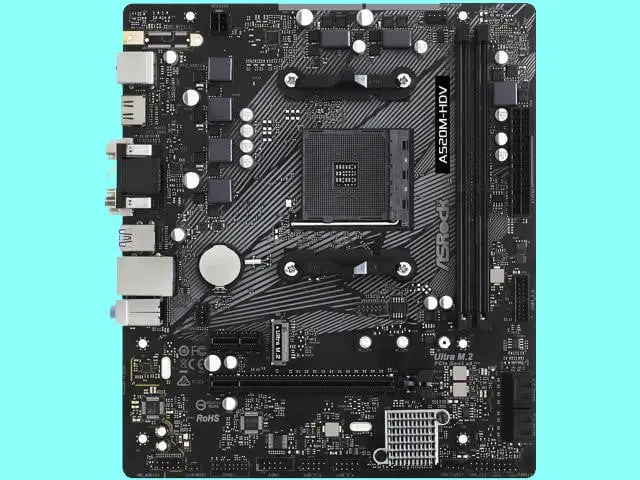
PCIe
First on the least, we have AMD’s A520 chipset, which is most comparable to Intel’s H510. However, unlike H510, A520 doesn’t support PCIe gen 4. This means you won’t be able to take advantage of the higher bandwidth of gen 4, even with a supporting 3000 or 5000-series Ryzen CPU.
While the newest generation of graphics cards come equipped with PCIe gen 4, they don’t see much benefit from it (gen 3 bandwidths are still high enough to avoid bottlenecking performance significantly, even with the RTX 3090 or RX 6900XT. And since PCIe is backwards compatible, you’ll still be able to use any gen 4 peripherals on an A520 board.
The main area where you’ll see performance loss is in storage speeds; you won’t be able to take advantage of the lightning-fast speeds of gen 4 NVMe SSDs. Truthfully, even this shouldn’t matter too much. Many gen 3 drives offer transfer speeds of up to 3500 MB/s, quick enough to boot your OS in mere seconds and load games lightning-fast.
Overclocking
Perhaps of greater concern to many users is A520’s lack of CPU overclocking support. AMD processors are unlocked by default, but on these motherboards you won’t be able to increase their clock speeds above factory settings, for the most part. If you’re not an overclocking enthusiast, this shouldn’t be a big deal. Overclocking only minimally improves performance, and does so only when the CPU is the system bottleneck (it’s more common for the GPU to be the bottleneck).
Connectivity
Finally, the A520 is a bit limited in terms of connectivity, as compared to its more expensive peers. It offers 26 PCIe lanes, as compared to up to 30 for B550 and 36 for X570. It also supports up to 13 USB ports (5 x USB 3.2 Gen 2, 2 x USB 3.1, 6 x USB 2.0) and up to 4 SATA ports.
More USB ports will allow you to connect a greater number of peripheral devices including headphones, keyboards, mice, cameras, microphones, WiFi adapters, and more. Most A520 boards should have plenty, especially considering that most cases come with additional ports.
SATA ports are mainly used for hard drives or SATA SSDs, and four of these will be more than enough for the typical user. If you stockpile storage, though, this may be a reason to consider a better board.
Compatibility
A520 supports any Ryzen Zen 2 (3000-series) and Zen 3 (5000-series) processors, with the exception of 3000-series APUs (the Ryzen 3 3200G and the Ryzen 5 3400G). If you intend on using one of these, you’ll want to opt for a 400-series board like a B450.
B550

Next up, we have the B550 chipset. This improves upon the A520 in a number of ways, while still maintaining a reasonable cost. B550 is, by far, the best chipset for a mid-range build, and works well even in higher-end rigs.
PCIe
Unlike A520, B550 supports PCIe gen 4; each B550 board is equipped with 20 gen 4 lanes. In addition to these, B550 comes with up to 10 gen 3 lanes for a total of 30. Considering most graphics cards take up 16 lanes, this leaves up to 14 for any expansion cards or PCIe SSDs, a generous amount of wiggle room.
Speaking of SSDs, gen 4 support allows you to use the fastest ones available, should you wish to do so.
Overclocking
Any B550 board allows you to overclock your Ryzen CPU, allowing it to run at faster speeds. As long as you have sufficient cooling, this is an easy way to squeeze an extra bit of performance at no additional cost. As previously mentioned, the benefits will be relatively minimal, so unless you simply enjoy overclocking we wouldn’t classify OC support as a must-have.
Connectivity
As we noted above, up to 30 PCIe lanes allows for more expansion cards and storage than the 26-lane A520. B550 also supports up to 14 USB ports (6 x USB 3.2 Gen 2, 2 x USB 3.2 Gen 1, 6 x USB 2.0) and up to 8 SATA ports. These numbers vary from model to model so be sure to do your research before making a decision.
Compatibility
B550’s compatibility list is identical to A520: All Zen 2 and Zen 3 CPUs can be paired with a B550 board, excepting the R3 3200G and R5 3400G.
X570

Last but not least, we have the X570, AMD’s fanciest (and consequently most expensive) chipset. If you’re looking for top-of-the-line performance, you can’t go wrong with one of these.
PCIe
All X570 boards sport a monstrous 36 PCIe lanes, all of which are gen 4. This leaves 20 lanes free after adding in a discrete graphics card, some of which can be filled with a gen 4 SSD, if desired.
Overclocking
It will come as no surprise that the X570 supports CPU overclocking. X570 boards tend to be the best-suited for overclocking, as they generally feature the best VRMs and heatsinks. If you want to push your processor to its limits, a high-end X570 will best allow you to do so.
Connectivity
In addition to its 36 PCIe lanes, X570 also one-ups both A520 and B550 in a couple of other categories: Any given X570 board can have up to 14 SATA ports and 16 USB ports (4 x HiSpeed 480MBps, 12 x USB 3.2 Gen 2). These numbers are overkill for the average consumer, but at least you can resta ssured that you won’t run out of expansion ports.
Compatibility
X570 differentiates itself from A520 and B550 in a couple of ways; it supports AMD’s 2000-series of CPUs, as well as both 3000-series APUs.
Which Chipset is Best for You?
Now that you have a deeper understanding of the differences between each of AMD’s chipsets, we hope you find it easier to pick the right one for your rig. If you’re still not sure, here are a few guidelines:
If you’re building a budget PC, A520 is probably best for you. You probably won’t be buying the fastest storage or graphics card, so you won’t need PCIe gen 4 support. Additionally, it’s unlikely you’ll be too worried about overclocking, as you’re probably best saving money with a stock cooler. Thus, A520 is an excellent “budget board.”
On the other hand, if you’re dropping a bit more money on your PC it’s probably worth spending the money on a slightly nicer motherboard. If you fall into this category, the B550 is an excellent candidate; it offers some useful features that mid-range builds can take advantage of, without the excessive cost of X570.
If you’re shooting for the best performance possible and want a motherboard to match the rest of your system, an X570 is, of course, the best choice.
